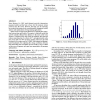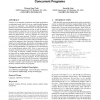822 search results - page 112 / 165 » Debugging Aspect-Enabled Programs |
GECCO
2010
Springer
14 years 1 months ago
2010
Springer
Evolutionary methods have been used to repair programs automatically, with promising results. However, the fitness function used to achieve these results was based on a few simpl...
POPL
2007
ACM
14 years 9 months ago
2007
ACM
Reuse distance (i.e. LRU stack distance) precisely characterizes program locality and has been a basic tool for memory system research since the 1970s. However, the high cost of m...
VL
2010
IEEE
13 years 7 months ago
2010
IEEE
Many dynamic programming language features, such as implicit declaration, reflection, and code generation, make it difficult to verify the existence of identifiers through standar...
SIGSOFT
2004
ACM
14 years 9 months ago
2004
ACM
In this paper, we describe PSE (Postmortem Symbolic Evaluation), a static analysis algorithm that can be used by programmers to diagnose software failures. The algorithm requires ...
SIGSOFT
2008
ACM
14 years 9 months ago
2008
ACM
Atomicity is an important specification that enables programmers to understand atomic blocks of code in a multi-threaded program as if they are sequential. This significantly simp...


